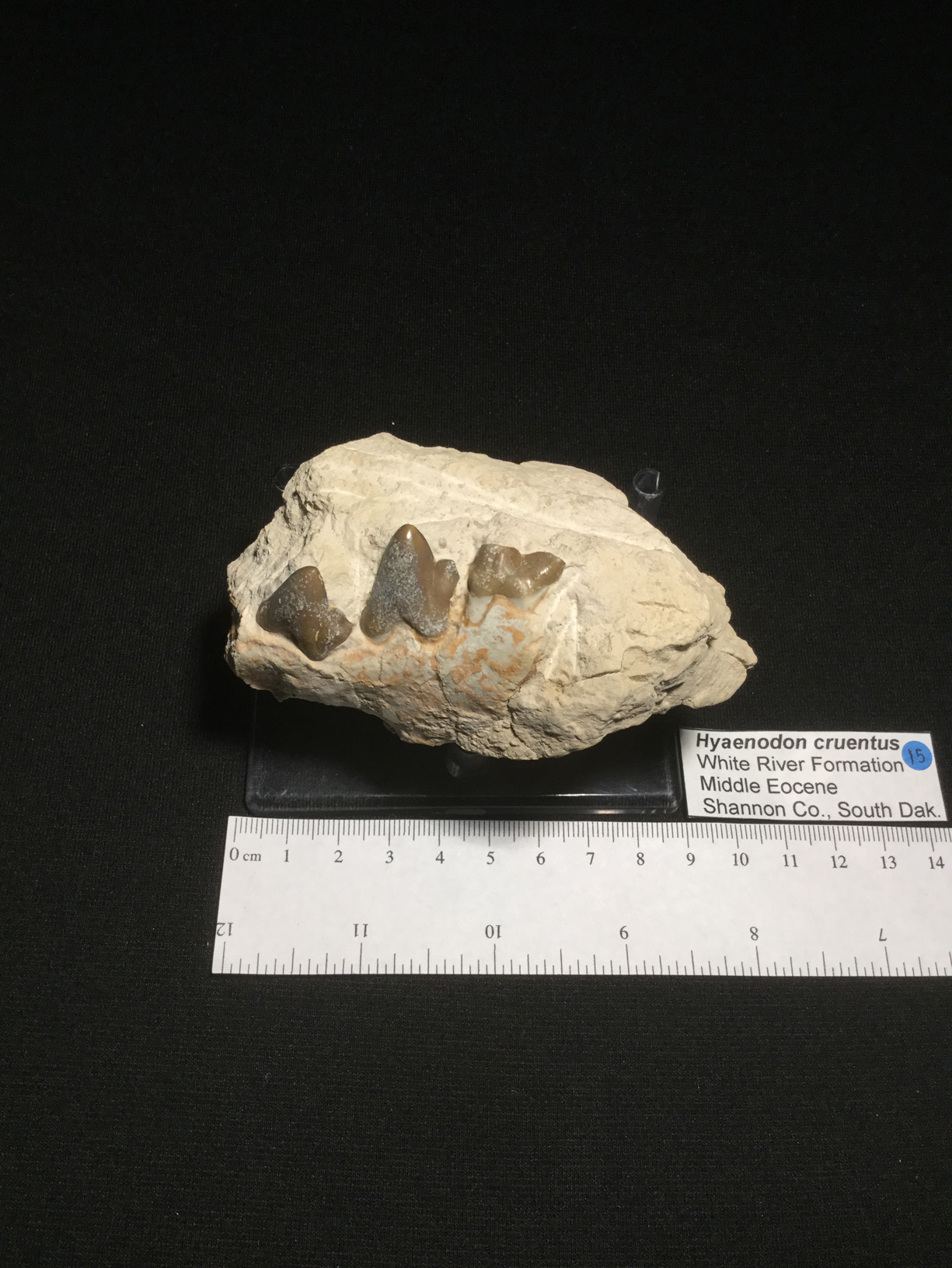
Oligocene Hyaenodon
Sorry, this item is no longer for sale
Hyaenodon cruentus
Brule Formation
White River Group
Middle Oligocene
Shannon County, South Dakota
Brule Formation
White River Group
Middle Oligocene
Shannon County, South Dakota
The specimen shown here is an excellent left-lower jaw section with three beautifully preserved teeth of this rare animal. The specimen is prepared in its original matrix. There is no repair or restoration. The jaw section is about 6 cm long. Hyaenodon is seldom found in the White River Badlands.
Hyaenadon cruentus belongs to a group of extinct mammals called creodonts. Creodonts existed from the Paleocene through Miocene periods (65-10 million years ago). The creodonts were the most dominant and diverse group of predators during the Eocene (55-40 million years ago) and Oligocene (37.5-26 million years ago) periods. They would have resembled modern day civets ,cats, or dogs.
The creodonts were made up of two families: the oxyaenids and Hyaenodontidae. The oxyaenids were small bodied with short legs and they became extinct by the end of the Eocene. The Hyaenodontidae had longer legs and were longer lived and more widely distributed. By the end of the Oligocene their numbers were significantly reduced with only one genus in Asia surviving into the Pliocene (10-3 million years ago).
Although their teeth were clearly adapted to eating flesh, creodonts were more primitive than true carnivores. Their teeth were less specialized than those of true carnivores. Their legs were not well suited to running and therefore likely unable to cope with faster prey which appeared at the beginning of the Miocene (26-10 million years ago).
Hyaenodon lived during the Oligocene. The Oligocene marked the start of generalized cooling of the earth. Glaciers formed in Antarctica during the Cenozoic Era (65 million years ago to the present) for the first time. Tropical climates diminished and cooler woodland and grassland climates became more widespread. The cooling trend culminated in the Ice Age of the Pliocene.
By the Oligocene, modern types of angiosperms (plants with an enclosed seed) had become widespread. The higher latitudes of the northern hemisphere would have changed from broad leafed tropical forest to temperate deciduous woodlands with evergreen and broad-leafed trees similar to those found on the North Island of New Zealand or the tip of the Cape of South Africa.
Hyaenodon is Latin for hyaena tooth. In Latin cruentus or crucians means torture or hard violence.
Hyaenadon cruentus belongs to a group of extinct mammals called creodonts. Creodonts existed from the Paleocene through Miocene periods (65-10 million years ago). The creodonts were the most dominant and diverse group of predators during the Eocene (55-40 million years ago) and Oligocene (37.5-26 million years ago) periods. They would have resembled modern day civets ,cats, or dogs.
The creodonts were made up of two families: the oxyaenids and Hyaenodontidae. The oxyaenids were small bodied with short legs and they became extinct by the end of the Eocene. The Hyaenodontidae had longer legs and were longer lived and more widely distributed. By the end of the Oligocene their numbers were significantly reduced with only one genus in Asia surviving into the Pliocene (10-3 million years ago).
Although their teeth were clearly adapted to eating flesh, creodonts were more primitive than true carnivores. Their teeth were less specialized than those of true carnivores. Their legs were not well suited to running and therefore likely unable to cope with faster prey which appeared at the beginning of the Miocene (26-10 million years ago).
Hyaenodon lived during the Oligocene. The Oligocene marked the start of generalized cooling of the earth. Glaciers formed in Antarctica during the Cenozoic Era (65 million years ago to the present) for the first time. Tropical climates diminished and cooler woodland and grassland climates became more widespread. The cooling trend culminated in the Ice Age of the Pliocene.
By the Oligocene, modern types of angiosperms (plants with an enclosed seed) had become widespread. The higher latitudes of the northern hemisphere would have changed from broad leafed tropical forest to temperate deciduous woodlands with evergreen and broad-leafed trees similar to those found on the North Island of New Zealand or the tip of the Cape of South Africa.
Hyaenodon is Latin for hyaena tooth. In Latin cruentus or crucians means torture or hard violence.





